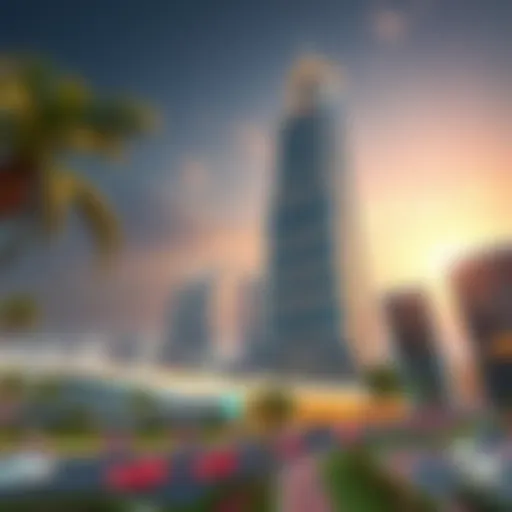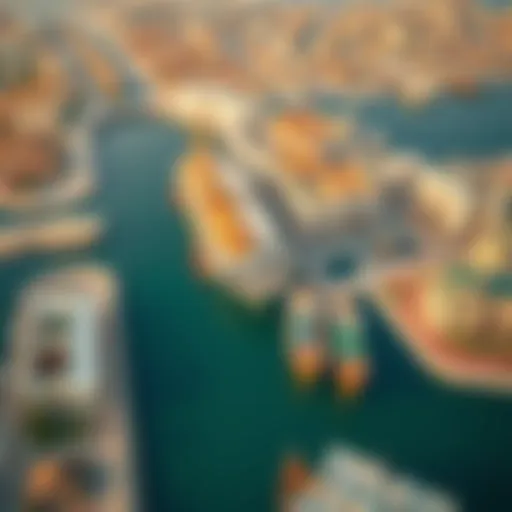Architectural Impact of Building 7 in Dubai
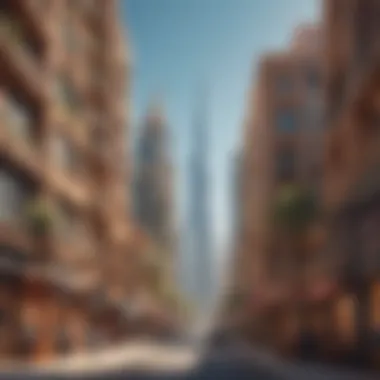

Intro
Building 7 in the Dubai Design District emerges as a cornerstone of modern architectural thought, embodying a wave of innovation that seeks to redefine urban landscapes. Nestled in one of the world's most dynamic creative hubs, this structure not only serves functional purposes but also plays a pivotal role in cultural exchange and collaboration. The design philosophy behind Building 7 transcends mere aesthetics; it reflects the aspirations of a city that thrives on creativity and ingenuity.
As we explore the architectural significance of Building 7, we will illuminate its distinctive features, assess its impact on the surrounding neighborhood, and dissect how it weaves itself into the fabric of Dubai's burgeoning artistic scene. By examining these facets, we will gain deeper insights into the ongoing architectural dialogue that Building 7 encourages within its community.
Preface to Dubai Design District
Located in the heart of Dubai, the Design District is not just another urban space; it emerges as a hub for creativity and innovation. This unique area brings together various sectors interconnected by art, design, and technology. In our exploration of Building 7, it becomes clear that this architectural marvel is deeply intertwined with the evolving landscape of the district itself.
This section sets the stage for understanding how the Dubai Design District operates, its significance in the broader context of urban development, and why Building 7 has become a focal point of interest for expatriates, tourists, locals, and real estate agents alike. The district isn't merely about commercial enterprises; it embodies a vision of community, collaboration, and inspiration.
Historical Context
The Dubai Design District's roots can be traced back to the city’s ambitious vision of becoming a global center for business and arts. Over the last decade, Dubai has evolved from being primarily a trade and tourism front, into a realm where design, fashion, and technology converge.
In inception, this initiative aimed to attract creative professionals and entrepreneurs from around the world, fostering a melting pot of cultures and ideas. As development progressed, the conceptual framework was established, balancing modern architectural designs with the importance of green spaces and community engagement. It's crucial to appreciate this historical context, as it shapes our understanding of Building 7’s role in this dynamic space.
Vision and Objectives
The vision behind the Dubai Design District focuses on redefining the urban experience. It aspires to create a lively ecosystem where artistic expression thrives. With a robust backbone of objectives, the district aims to:
- Promote Creativity: By establishing co-working spaces, galleries, and exhibition areas, it serves as a platform for artists and designers.
- Encourage Innovation: Through incubators and collaborative spaces, fresh ideas can take root and grow.
- Cultivate Community: Initiatives that connect local artisans with broader markets are essential to the district's allure.
Building 7 exemplifies these ambitions perfectly. It symbolizes how modern architecture can be a key player in promoting social engagement and cultural exchange, making it a significant asset in this creative ecosystem. As we move forward in this article, we will further dissect the architectural significance of this captivating building.
Overview of Building
In the ever-evolving landscape of the Dubai Design District, Building 7 stands as a pivotal structure that encapsulates the ethos of modern architectural thought. It's not just about bricks and mortar; this building serves as a vibrant stage for creativity and collaboration within the arts. In examining Building 7, one uncovers not only its architectural merits but also its role in fostering a dynamic environment for artists, entrepreneurs, and designers.
The importance of this exploration lies in understanding how Building 7 correlates with the broader goals of the Dubai Design District. It acts as a beacon for innovation, representing an intersection where cutting-edge design meets practical functionality. The architectural significance of Building 7 reveals a narrative that is both forward-thinking and rooted in cultural dialogues.
Architectural Design
Architectural Style
The architectural style of Building 7 is a testament to contemporary design principles that emphasize transparency and connectivity. One can discern how large glass facades invite natural light, creating a warm and open atmosphere. This characteristic is not just visually appealing but also enhances the user experience, aligning with the goals of fostering collaboration and creativity. What sets this style apart is its minimalism; it avoids unnecessary ornamentation yet still manages to convey a sense of grandeur. This sort of approach meets the needs of the modern workforce searching for environments that stimulate creativity while maintaining functional integrity.
Innovative Materials
When considering innovative materials, Building 7 showcases a commitment to sustainability and aesthetic appeal. The incorporation of recycled and eco-friendly materials speaks volumes about the design philosophy underpinning the structure. This focus on materials helps reduce the carbon footprint and also invites conversations about sustainable practices in architecture. The unique use of lightweight yet high-strength materials allows for expansive floor plans and encourages the versatility necessary for creative workspaces. This not only benefits the environment but enhances the functionality of the building, making it a popular choice among tenants.
Environmental Considerations
Environmental considerations in Building 7 have been skillfully integrated into its design. Features like green roofs and energy-efficient sustainability measures demonstrate a deep commitment to reducing energy consumption. These choices align well with global trends towards ecological construction. The advantages of these environmental strategies culminate in lower operational costs and a healthier living and working environment. Choosing to prioritize these considerations not only serves the immediate occupants but sends a clear signal about the possible futures of sustainable urban development.
Size and Layout
Floor Plans
Floor plans in Building 7 are designed to maximize flexibility and adaptability. This key feature allows for a variety of layouts that can morph according to the specific needs of occupants. The open-plan design supports collaborative environments, fostering interaction among various creative fields. Such layouts are increasingly sought after in modern architecture as they encourage spontaneous meetings and idea exchanges. However, it is essential to balance open spaces with areas that provide privacy, ensuring that individuals can focus when necessary.
Spatial Dynamics
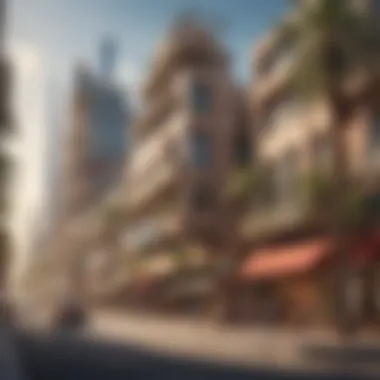

The spatial dynamics of Building 7 emphasize movement and flow throughout its areas. This characteristic is crucial as it mitigates crowding and allows for easy navigation. By employing concepts such as sightlines and strategically positioned common areas, designers have created a harmonious experience. This consideration benefits everyone from artists looking for inspiration to corporate tenants wanting functionality in their surroundings. However, one must also acknowledge that maximizing open space can sometimes lead to challenges in acoustics, requiring thoughtful solutions to minimize distractions.
Functional Areas
Functional areas within Building 7 are meticulously arranged to optimize utility and accessibility. Each zone, from co-working spaces to meeting rooms, is intentionally designed to serve its purpose while contributing to the building's overall synergy. The key characteristic here is versatility; these spaces can be utilized in multiple ways. The mixed-use nature not only makes it a wise choice for diverse tenants but also creates an inclusive atmosphere that can attract a range of events. Yet, it's vital to remain aware of the potential for overcrowding in popular areas, necessitating careful scheduling to maintain a productive ambiance.
Building 7 in the Dubai Design District represents a pioneering approach to architectural design that emphasizes flexibility, sustainability, and community engagement. Its thoughtful layout and innovative materials contribute fundamentally to its significance as a creative hub in Dubai.
Key Features of Building
Building 7 stands as an exemplar of contemporary architecture, emphasizing sustainability and innovation. Exploring its key features reveals not just a physical structure but a gathering space that aims to cultivate creativity and collaboration. The blend of sustainability initiatives and technological innovations represents a shift from traditional design perspectives. In this section, we delve into the various pivotal aspects that make Building 7 an integral part of Dubai Design District's evolving landscape.
Sustainability Initiatives
Building 7 actively incorporates sustainability initiatives that ensure a responsible approach to architecture. By doing so, it sets a benchmark in environmentally conscious design. Three critical elements under this umbrella are energy efficiency, water conservation, and recyclable materials.
Energy Efficiency
Energy efficiency is one of the standout features of Building 7. It employs state-of-the-art systems and technologies, reducing energy consumption significantly. This commitment to minimizing the carbon footprint is not just practical but also aligns with global best practices.
- Key characteristic: Utilization of advanced HVAC systems and renewable energy sources.
- Popularity: Such initiatives are becoming increasingly important as the world shifts towards greener practices.
- Unique advantages: For instance, the natural light optimization reduces reliance on artificial lighting, creating a pleasant working environment. However, it is critical to note that while upfront costs may be higher, the long-term savings and environmental impact make it a wise choice.
Water Conservation
Water conservation efforts are equally noteworthy. Building 7 implements several strategies to reduce water usage, which is crucial for a region like Dubai where water scarcity is a real concern.
- Key characteristic: Incorporating rainwater harvesting systems and low-flow fixtures ensures responsible usage of this vital resource.
- Beneficial choice: With these strategies, not only is there a reduction in water consumption, but it also raises awareness within the community about the importance of conservation.
- Unique features: For example, the use of drought-resistant landscaping minimizes water demand. While these systems require careful management, their benefits are significant, particularly in promoting sustainability.
Recyclable Materials
Building 7 makes an impressive move by using recyclable materials in its structure, showcasing a commitment to reducing waste. This choice highlights an important aspect of modern architecture, where environmental considerations take center stage.
- Key characteristic: Use of materials like reclaimed wood and recycled steel.
- Popularity: As sustainability becomes more mainstream in construction, buildings that prioritize these materials gain an edge in attracting conscientious tenants.
- Unique feature: Many of these materials are sourced locally, which not only reduces transport emissions but also supports local economies. The challenge lies in balancing cost and availability, but the long-term sustainability benefits far outweigh these issues.
Technological Innovations
In addition to sustainable practices, Building 7 is at the forefront of technological innovations, enhancing its role as a modern workspace. This approach not only transforms the interior environment but further solidifies its status as a creative hub.
Smart Building Systems
Smart building systems comprise a critical aspect of Building 7, where the integration of technology enhances efficiency and user experience.
- Key characteristic: Automated lighting, climate control, and security systems create a seamless experience.
- Popularity: As technology becomes ubiquitous, such systems are increasingly sought after, making buildings like Building 7 attractive options for businesses.
- Unique features: The real-time monitoring capabilities allow for quick adjustments based on occupancy, which leads to optimal resource utilization. While initial setups may be complex and costly, the resulting efficiency gains are profound.
Integrated Design Tools
Integrated design tools play a crucial role in the planning and execution of Building 7's architecture, ensuring that every aspect works in harmony.
- Key characteristic: Using software to visualize and simulate building performance early in the design phase.
- Beneficial choice: This approach helps mitigate issues before construction begins. Employing these tools does require investment, but the preventive benefits are undeniable.
- Unique feature: The feedback loops from these tools allow for iterative designs, keeping the building adaptable and efficient long-term. There can be a steep learning curve for teams unfamiliar with technology, but the potential for better outcomes is compelling.
Future-Proofing Strategies
Last but not least, future-proofing strategies are embedded in Building 7’s design philosophy. This ensures that the building remains relevant as technological advancements occur.
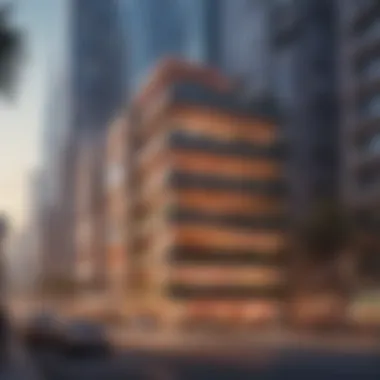

- Key characteristic: Flexibility in spaces allows for easy upgrades and modifications.
- Popularity: Thus, new tenants are more likely to consider such spaces over traditional office environments.
- Unique features: Integrating modular designs allows for a quick adaptation to changing needs. However, maintaining this adaptability requires thoughtful planning and foresight, which is often challenging.
Building ’s Role in the Creative Ecosystem
Building 7 plays a pivotal role in nurturing creativity and synergizing talent within the bustling Dubai Design District. This structure goes beyond its physical presence; it's an incubator for innovative ideas and collaborations. As artists, entrepreneurs, and designers flock to this center, they find not only space but a vibrant community that fuels their aspirations.
A Collaborative Workspace
Co-Working Spaces
Co-working spaces in Building 7 are more than just desks and chairs. They provide an environment where creativity can flourish. One key characteristic of these spaces is their flexibility. They allow for various configurations—whether you need a quiet nook for concentration or an open area for brainstorming sessions. This adaptability makes co-working spaces a popular option.
What sets these co-working areas apart is their focus on fostering collaboration. Often, these spaces host events, workshops, and informal gatherings that encourage networking among creative minds. The benefit here is clear: individuals can share ideas, get feedback, and build relationships that might lead to future projects.
Meeting Facilities
When it comes to meeting facilities, Building 7 does not cut corners. These rooms are designed with modern technology and comfort in mind. A key characteristic here is the audio-visual setup that caters to diverse needs, from intimate discussions to larger presentations. This flexibility makes these meeting spaces valuable for individuals to convey their ideas effectively.
The unique feature of the meeting facilities is their aesthetic design, often incorporating elements that reflect the creative spirit of the building. This can inspire those within the space, giving meetings a more vibrant touch. However, the considerable demand for these spaces can sometimes lead to scheduling challenges, requiring users to plan ahead.
Networking Opportunities
Networking opportunities abound in Building 7. The atmosphere here is infused with creativity, promoting connections among professionals in various fields. One of the main characteristics of this ecosystem is the variety of events organized—ranging from panel discussions to art showcases. These activities serve as engaging platforms for individuals to meet and exchange ideas.
Perhaps the most unique aspect of the networking opportunities in Building 7 is the diversity of participants, which spans multiple creative disciplines. The advantage lies in the rich tapestry of perspectives and experiences. However, for newcomers, diving into such a network can be daunting, but the inclusive environment helps ease this transition.
Attracting Talent and Innovation
Residency Programs
Residency programs at Building 7 stand out as avenues for artists and designers to immerse themselves in their craft. A notable characteristic of these programs is their structured yet flexible framework, allowing participants to explore their ideas while receiving mentorship from industry veterans. This blend of guidance and autonomy makes them a highly sought-after initiative.
The unique feature of residency programs is the opportunity to showcase work in progress to the public. This exposure boosts visibility and opens pathways to collaboration. However, the competitive nature of these programs means only a few can get in, which can make access tough.
Incubator Spaces
Incubator spaces within Building 7 foster nascent ideas and provide essential resources for startups. A critical aspect of these spaces is their comprehensive support system, offering everything from business development advice to networking connections. This makes them an attractive choice for innovative minds looking to bring their concepts to life.
What makes these incubators particularly effective is the access to a diverse pool of talent, which can lead to partnerships that might not happen elsewhere. That said, the pressure to deliver results quickly can be overwhelming for some, requiring participants to maintain a razor-sharp focus.
Art and Design Exhibitions
Art and design exhibitions in Building 7 serve as critical platforms for showcasing local talent. One key characteristic is their diversity; exhibitions feature everything from emerging artists to established names, creating a rich dialogue. This eclectic approach not only entertains but educates visitors about various artistic expressions.
The advantage of these exhibitions is their role in setting trends and sparking conversations within the community. They can attract both local residents and tourists, breathing life into the area. However, the challenge lies in balancing the events; ensuring there's always something fresh and relevant to keep audiences engaged.
Building 7 does not just serve as a venue; it’s a heartbeat for the creative community in Dubai, resonating with the pulse of innovation.
Community and Cultural Impact
The architectural landscape of Building 7 in the Dubai Design District does more than house artistic endeavors and professional innovation; it plays a key role in shaping community interactions and the cultural fabric of the area. By fostering spaces for various expressions—be it through art, workshops, or social gatherings—Building 7 becomes a living monument where creativity thrives and ideas collide. This section will explore how the initiatives tied to this building facilitate a platform for cultural exchange and local engagement, ultimately enhancing the social dynamics of Dubai.
Fostering Cultural Exchange
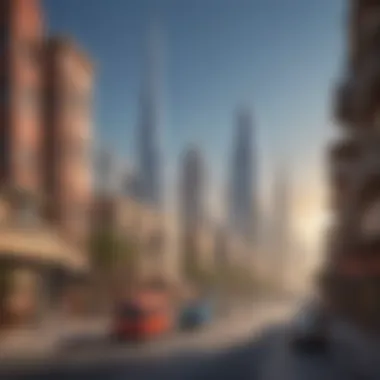

Art Installations
Art installations located within and around Building 7 highlight the significance of visual storytelling in our daily experiences. These artworks are not just aesthetically pleasing; they also serve as a medium through which artists express thoughts, provoke discussions, and challenge perceptions. One of the unique features of these installations is that they often involve collaborations between local and international artists. This collaboration showcases not only the technical skills of the creators but also the cultural narratives they bring along.
The advantage here is clear: it creates a dialogue between different cultures, bridging gaps and fostering understanding among diverse groups. The downside might be space constraints or the transient nature of some installations, which could limit how long the community can engage with specific artworks. Nonetheless, these installations remain a key component of the cultural identity of Building 7.
Cultural Workshops
Cultural workshops held at Building 7 provide participants the opportunity to immerse themselves in a hands-on experience of varied art forms, from pottery to digital design. These workshops equip individuals with practical skills while promoting cultural literacy. They are a beneficial choice, as they invite not only artists but also everyday people to explore creativity collectively.
One key characteristic of these workshops is their inclusivity; they cater to all skill levels and ages. However, they depend heavily on participation and sometimes can fall flat if community interest wanes. Still, the unique advantage lies in their capacity to build bonds among participants, fostering a sense of belonging and shared identity.
Public Events
Public events, ranging from art fairs to performance showcases, are crucial for making the cultural offerings of Building 7 accessible to a broader audience. These events often feature local artists and performers, which helps highlight the talent present in the community while also drawing attention to the vibrancy of the Dubai Design District.
A notable characteristic of these events is their scalability. From intimate gatherings to large festivals, they create opportunities for networking and collaboration. However, potential downsides include logistical challenges and varied audience engagement depending on the event type. Overall, public events help cement Building 7's role as a cultural hub within the city.
Local Engagement
Partnerships with Local Artisans
Building 7 has also established partnerships with local artisans, which fortifies its commitment to nurturing homegrown talent and innovation. Artisan-driven initiatives spotlight traditional crafts and practices, ensuring their survival in a rapidly modernizing landscape. This approach not only champions local culture but also enhances the authenticity of the offerings in the district.
A key advantage is the richness these partnerships bring to the community. Crafts and trades that have been passed down through generations can be showcased alongside contemporary artistic expressions. However, challenges arise in terms of funding and resources needed to support these artisans adequately. Nonetheless, these partnerships contribute to the cultural richness of Building 7.
Community Programs
Various community programs anchored in Building 7 outreach wider demographics. These programs often seek to educate and empower local residents, highlighting the intersection of art, culture, and social issues. By tackling relevant topics, they encourage civic engagement and foster critical discussions.
One standout feature of these programs is their flexibility to adapt to the aspirations and concerns of the community. This adaptability is a major benefit, as it ensures sustained interest and relevance. On the downside, maintaining a consistent level of participation can sometimes be challenging. However, the overall contribution to civic identity cannot be understated.
Support for Local Businesses
Support for local businesses is integral to the holistic approach of Building 7. By partnering with nearby shops and eateries, the building creates a symbiotic relationship where both the arts and commerce can thrive. This collaboration is vital not only for economic sustainability but also for enhancing community ties.
The collaborative nature helps to elevate the profiles of local businesses, drawing foot traffic from events and programs happening at Building 7. One specific advantage is the visibility it grants to unique local offerings, making them known to a wider audience. However, smaller businesses might struggle to keep up with larger competitors, which can lead to uneven support. Overall, strength lies in the coalition of local enterprises supporting one another within the cultural ecosystem of Building 7.
Finale: The Future of Building
Building 7 in Dubai Design District is more than just an architectural feat; it symbolizes a shift in how creative spaces can influence modern urban life. As the landscape of the Dubai Design District continues to evolve, the prospects for Building 7 are vast and multi-faceted. This conclusion emphasizes the importance of continuing investment in both the building's infrastructure and its role within the creative economy.
Potential Developments and Collaborations
Looking forward, Building 7 is poised for a range of exciting potential developments. Collaboration can be the name of the game here, as various stakeholders—from local artists to global tech firms—join forces. The possibility of integrating cutting-edge technology into the building's walls could enable a whole new level of interactivity. Think augmented reality studios or virtual design platforms accessible within the workspace.
Moreover, the concept of partnerships isn't just a business tactic; it's about creating a fertile ground for ideas to blossom. Imagine art exhibits that don't just showcase local talent but also invite international artists for cultural exchange. Community initiatives could provide workshops or programs aimed at young designers and creatives. These collaborations could create environments where ideas cross-pollinate, pushing the boundaries of art and design.
- Brand collaborations: High-profile collaborations with international brands could help establish Dubai as a global design hub, attracting even more attention to Building 7.
- Sustainability initiatives: Keeping up with trends, we can expect more focus on sustainable practices involving locally sourced materials and eco-friendly designs.
Building as a Catalyst for Change
The transformation of Building 7 goes hand in hand with its potential to serve as a catalyst for change. In a city like Dubai, where innovation is the norm, Building 7 could set new standards for urban living and working spaces. By embracing new forms of technology, architecture, and, crucially, community involvement, the building can inspire other districts to rethink their structures and purposes.
There's something inherent about being part of a creative ecosystem that stimulates growth. The engagement with local artisans can lead to a ripple effect throughout the community. As Building 7 becomes a hub for art and innovation, it could encourage similar initiatives in neighborhoods nearby. In this way, the finish line isn't just about completing projects but about forming a lineage that carries the spirit of creativity forward.
"Innovation is not just about what we create, but also how we create communities that support that creation.”
In summary, as Building 7 charts its course into the future, it stands to redefine not only the parameters of artistic expression but also community engagement in urban settings. With potential developments and collaborative projects already on the horizon, the building is set to maintain its pivotal role in Dubai's thriving design landscape.







